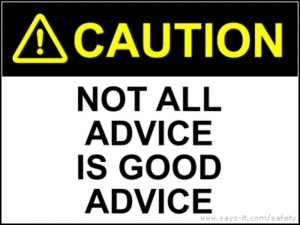I am sure you can argue with this one.
Sometimes a board member is valuable in teaching the “how” to get things done inside the company. But experience reinforces the usual fact that a board member telling the CEO or founder “how” to perform a function crosses a line and can diminish the CEO’s confidence and denigrates his or her ability, often in front of the board itself.
Let’s start with the vision for the enterprise
Who is responsible for the vision that drives the company? This is arguably the primary job of the CEO, with agreement from the board. Many entrepreneurs after taking outside investment defer to their board for matters of direction that include setting the vision, as well as executing the plan.
job of the CEO, with agreement from the board. Many entrepreneurs after taking outside investment defer to their board for matters of direction that include setting the vision, as well as executing the plan.
The general rule for founders and CEO’s with a board
Here is a general rule: The CEO sets the sails and points the ship, creating the vision for the company. The board provides input into that vision, testing it against their experience and reason, and challenges it as a part of its duty to protect the shareholders and care for the corporate asset. The board then assures that management receives or has resources to affect the vision, monitoring progress at each step.
What the board does not do
[Email readers, continue here…] The board does not get involved in how the job is done, but rather why it should be done and perhaps when it should be completed.
How a board member can harm the CEO
Once the members, unless invited in a consulting role, involve themselves in execution of the plan, management is robbed of its principle responsibility – execution of the plan approved by the board. When that happens, even a good CEO will pause and defer to the board before making strategic operational decisions, slowing the progress, perhaps endangering the company, by allowing competition to gain ground, and sometimes ceding some control to board members who are remote from the operation and may not be the wisest of advisers in each situation.
While we are on the subject, next up will be how to handle a dysfunctional board. Stay tuned…

 from professional investors. Two members usually represent the founders or management, two are from the investors, and one is often elected by the four to represent the industry in which the company works.
from professional investors. Two members usually represent the founders or management, two are from the investors, and one is often elected by the four to represent the industry in which the company works. I still recall vividly the board of a young company that was composed of the entrepreneur and four investors, each of whom had differing thoughts on how to use resources to grow the company, giving mixed signals to the entrepreneur who wanted greatly to please each and all. That company embarked upon an expansion drive before perfecting the operation in its first city, as a result of the board’s direction to the entrepreneur, which was against his better judgment although he remained relatively quiet and certainly compliant.
I still recall vividly the board of a young company that was composed of the entrepreneur and four investors, each of whom had differing thoughts on how to use resources to grow the company, giving mixed signals to the entrepreneur who wanted greatly to please each and all. That company embarked upon an expansion drive before perfecting the operation in its first city, as a result of the board’s direction to the entrepreneur, which was against his better judgment although he remained relatively quiet and certainly compliant. that the entire team must know without question and execute without pause in order to win games and advance toward the playoffs.
that the entire team must know without question and execute without pause in order to win games and advance toward the playoffs. You as a business leader are the coach for your team, no matter what the size. Trained employees execute their tasks better than those who are not. You are responsible for the training and for the outcomes both for individuals and the team. You set the goals and develop the metrics by which your team is measured against those goals. You publish the metrics and use them to focus and align your team to perform even better.
You as a business leader are the coach for your team, no matter what the size. Trained employees execute their tasks better than those who are not. You are responsible for the training and for the outcomes both for individuals and the team. You set the goals and develop the metrics by which your team is measured against those goals. You publish the metrics and use them to focus and align your team to perform even better. impossible to overcome. Our development team is stumped with a problem; or the marketing organization cannot come up with a theme for the next campaign; or the team has hit a wall where further speed, size reduction, or other constraint seems impossible to overcome.
impossible to overcome. Our development team is stumped with a problem; or the marketing organization cannot come up with a theme for the next campaign; or the team has hit a wall where further speed, size reduction, or other constraint seems impossible to overcome. First: Swarming. The project leader presents a problem to the entirety of the inside network of stakeholders, including suppliers and even customers if appropriate, and opens a channel for easy communication between the players. The group interacts quickly, and solutions seem to fly in from several sides, tested and refined by the swarm until solved.
First: Swarming. The project leader presents a problem to the entirety of the inside network of stakeholders, including suppliers and even customers if appropriate, and opens a channel for easy communication between the players. The group interacts quickly, and solutions seem to fly in from several sides, tested and refined by the swarm until solved. property foundation, the thing that makes your business most valuable to customers, investors and perhaps someday to potential buyers of the business. Every business has an intellectual foundation where the CEO’s knowledge and vision create a barrier to entry that deflects some or much of the potential competition.
property foundation, the thing that makes your business most valuable to customers, investors and perhaps someday to potential buyers of the business. Every business has an intellectual foundation where the CEO’s knowledge and vision create a barrier to entry that deflects some or much of the potential competition. the most recent good work you’ve done for them and for the organization.
the most recent good work you’ve done for them and for the organization. If you find yourself having to share your time between a distant location and home base, whether because of constant travel or living in a remote spot, you should redouble your energy – focusing your people at all levels toward being able to make decisions with skill and confidence. You should hone your skills of delegation with accountability and practice your communication skills so that short communications count more than ever.
If you find yourself having to share your time between a distant location and home base, whether because of constant travel or living in a remote spot, you should redouble your energy – focusing your people at all levels toward being able to make decisions with skill and confidence. You should hone your skills of delegation with accountability and practice your communication skills so that short communications count more than ever. this out. And there should be an equal – if not stronger – bit of a student in each of us as well, allowing us to drop our egos a notch and ask for help when we need it. There is no shame in admitting ignorance in even the most unusual of circumstances. Yes, this is true, even when we may think we know the answer in advance.
this out. And there should be an equal – if not stronger – bit of a student in each of us as well, allowing us to drop our egos a notch and ask for help when we need it. There is no shame in admitting ignorance in even the most unusual of circumstances. Yes, this is true, even when we may think we know the answer in advance.
 in your chain – your key customers. During CEO roundtables which I attend regularly, fellow CEO’s analyze a compatriot’s use of time during the once-a-year personal presentations each makes in turn. If the presenting CEO is honest in the analysis of actual time spent each week, it is often revealing to all to see how many hours are spent turning inward toward meetings, operational management, or responding to emails or texts sent by others.
in your chain – your key customers. During CEO roundtables which I attend regularly, fellow CEO’s analyze a compatriot’s use of time during the once-a-year personal presentations each makes in turn. If the presenting CEO is honest in the analysis of actual time spent each week, it is often revealing to all to see how many hours are spent turning inward toward meetings, operational management, or responding to emails or texts sent by others. Do customers know what they want from their suppliers for future products? We often ask our sales people to “find the pain” and show how our product solves that pain problem. But it was Henry Ford who famously said, “If I’d asked my customers what they wanted, they would have said ‘a faster horse’.” Some new products arrive with no frame of reference. FedEx, the automobile, the Internet, and many more examples, prove that there can be a significant market for ground-breaking ideas.
Do customers know what they want from their suppliers for future products? We often ask our sales people to “find the pain” and show how our product solves that pain problem. But it was Henry Ford who famously said, “If I’d asked my customers what they wanted, they would have said ‘a faster horse’.” Some new products arrive with no frame of reference. FedEx, the automobile, the Internet, and many more examples, prove that there can be a significant market for ground-breaking ideas. built upon newer technology.
built upon newer technology. Wouldn’t you rather obsolete yourself than watch helplessly as someone else does that for you?
Wouldn’t you rather obsolete yourself than watch helplessly as someone else does that for you? The worrying that always precedes a change
The worrying that always precedes a change